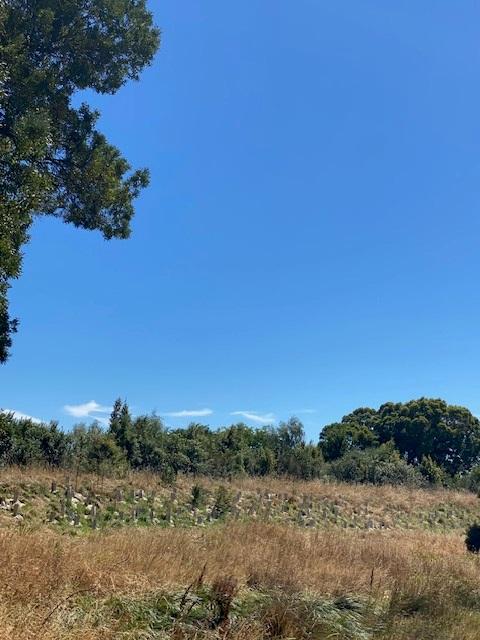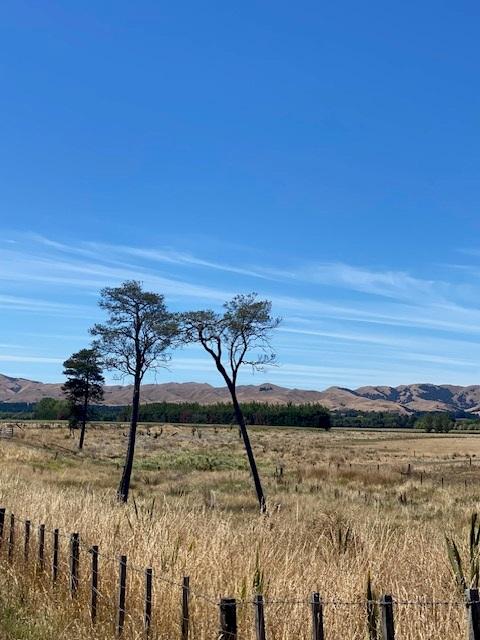Words by Lucy Riddiford
As I drive along the road from Martinborough to Ruamāhanga Farm, I look to the right at Jenkins Dip and see with pride the trees that we planted last winter, all carefully tucked up in their tree guards, cleared and encircled with sheep dags to discourage weeds and give them the best chance of growing to adulthood. I feel a sense of achievement. This looks planned!

View of the lower wetland from Jenkins Dip
Three years ago, we started to think in earnest about regenerating the wetland. With the clearing of crack willow, the three kahikatea (the three sisters) were uncovered and the possibilities started to emerge. I could actually imagine what had been there and what could be again.

The “three sisters”. I am the third (most robust) one. We think that I am flourishing even more, as the planting develops – I have someone to communicate with.
The first year I felt like a bit of a fraud – “we’re doing a wetland project” we’d say confidently – when all we had really done was exclude stock to see what would grow naturally. It felt a bit like the Emperor’s New Clothes. Showing my friend in the summer months, she looked dubiously at the parched earth and asked politely where the wetland actually was.
But three years on, it is starting to feel like a real ‘thing’. With some grant funding from Trees that Count and the help of numerous volunteers, the planting is starting to take shape. And it is forming a platform for some of the other work that Jane and Rod want to do around health, education and wellbeing, as well as being advocates for the river, building on their experience with Global Generation in London. And now we are close to establishing a charity to support the work.
So, what was my attraction to being involved? I grew up at Ruamāhanga Farm from the age of 5, but did not have quite the same affinity to the land as my sisters. I believe deeply that action needs to be taken to address climate change, but am perhaps less keen on the hands on mahi (my sisters had to teach me how to plant a tree last winter, as I was embarrassed about my lack of skills in front of some of our volunteers). I love nature and hiking in particular, but hadn’t felt the need to be part of creating it. I was more likely to be found inside with a book than on the farm.
The opportunity really shifted for me, when I could see what skills I could bring to the enterprise – and they didn’t necessarily need to be the hands on ones. I have had the privilege in my working career of having leadership roles. I am a lawyer and have always applied my craft in a broader sense – solving complex problems, building relationships, building culture – achieving outcomes through collaboration. I could see suddenly what I could bring to the mix. I was excited at the prospect of building a partnership with tangata whenua, again drawing on what I’d learned from working with our Te Tiriti partnerships team at work, as they build partnerships with mana whenua in Auckland.
In the past, I had shied away from too much involvement in the farm, not liking the idea of “being in business” with my family. But now, the messiness and complexity of working with family was attractive – for me the juice! Unlike most jobs, I can’t just walk away when things get tough. We need to achieve consensus. It’s not always easy, but by being transparent, working through things – and on things – together, we are finding that often through differences of opinion, we can create something magical together, something that couldn’t be achieved individually. It’s our secret sauce.
I love the different perspectives that my two sisters bring. Rod brings something else again, he’s better at listening than we are and has an ability to distill things to their essence. And Yvonne also continues to provide huge support and challenge when needed.
I feel very lucky to be involved with Ruamāhanga mauri oho, which provides a deeper purpose, which is complementary to much of my work, but will be much more enduring.

Photo taken in Japan, walking the kumano kodo – the cedars and cypress providing an inspiration for what might be one day with trees native to our part of the Wairarapa.